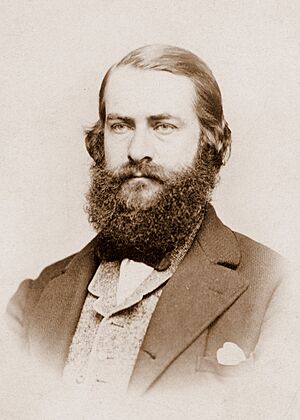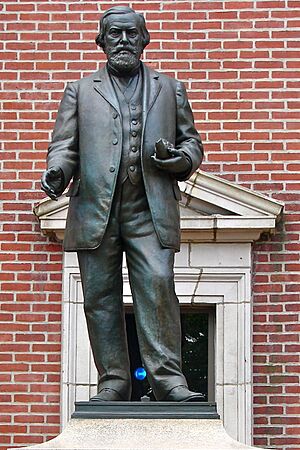Joseph Leidy facts for kids
Quick facts for kids
Joseph Leidy
|
|
|---|---|

Leidy c.1870
|
|
| Born | September 9, 1823 |
| Died | April 30, 1891 (aged 67) Philadelphia, Pennsylvania, U.S.
|
| Nationality | American |
| Alma mater | University of Pennsylvania |
| Awards | Lyell Medal (1884) |
| Scientific career | |
| Fields | paleontology, anatomy, parasitology |
| Institutions | Academy of Natural Sciences University of Pennsylvania Wagner Free Institute of Science |
| Signature | |
 |
|
Joseph Mellick Leidy (born September 9, 1823 – died April 30, 1891) was an important American scientist. He was a paleontologist, meaning he studied fossils and ancient life. He also studied anatomy (the structure of living things) and parasitology (parasites).
Leidy taught anatomy at the University of Pennsylvania. Later, he became a professor of natural history at Swarthmore College. He also directed scientific programs at the Wagner Free Institute of Science. His book, Extinct Fauna of Dakota and Nebraska (1869), described many new species. It also showed many animals previously unknown in North America. The Leidy Glacier in Greenland was named after him by explorer Robert Peary.
Contents
Early Life and Education
Joseph Leidy was born on September 9, 1823. His family lived in Philadelphia and had German roots. His father, Philip, was a hatter. Joseph's mother, Catharine, died when he was very young. His father then married his mother's cousin, Christiana Mellick.
Joseph had a brother named Thomas. His father wanted him to be a sign painter. But with his stepmother's help, Joseph studied medicine. He went to the University of Pennsylvania. He earned his medical degree in 1844.
He married Anna Harden, who was very interested in his work. She often helped him with his studies. They did not have their own children. Later, they adopted a seven-year-old girl named Alwinia. She was the daughter of a professor from the University of Pennsylvania. In 1848, Leidy became a member of the American Philosophical Society.
Discovering Ancient Life
Leidy was a key figure in American paleontology. He named the first nearly complete dinosaur skeleton ever found. This was Hadrosaurus foulkii, discovered in New Jersey. Leidy was the first to suggest this dinosaur could walk on two legs. This was a new idea at the time.
He also described many other important fossil animals. These included the dire wolf (Aenocyon dirus) and the American lion (Panthera atrox). He also identified Arctodus (A. pristinus), a giant short-faced bear.
Edward Drinker Cope, another famous paleontologist, was Leidy's student. However, a big rivalry developed between Cope and Othniel Charles Marsh. This competition, known as the Bone Wars, made Leidy step away from studying western American fossils. Leidy had helped start this field of study.
Leidy supported Charles Darwin's idea of evolution early on. He helped Darwin become a member of the Academy of Natural Sciences in Philadelphia.
In 1852, Leidy correctly placed the North American fossil bison, Bison antiquus, into the Bison group. This "ancient bison" was common for over 10,000 years. It is a direct ancestor of today's American bison.
In 1855, Leidy published an important study on fossil ground sloths. This was the first full study of North American xenarthrans. This group includes sloths, armadillos, and anteaters. His work helped us understand these ancient creatures better. He showed how widespread Megalonyx jeffersonii once was.
Leidy also led much of the fossil research in Florida in the late 1800s. He described the newly found species Smilodon floridanus, a type of saber-toothed cat.
Leading the Wagner Institute
After William Wagner died in 1885, the Wagner Free Institute of Science needed a new leader. They chose Joseph Leidy for this role. He became the president of the institute's faculty and the museum's curator. He held these jobs while also working at the Academy of Natural Sciences and the University of Pennsylvania.
Under Leidy, the Wagner Institute became a more professional place for research. He started the institute's scientific journal. He also supported expeditions to collect specimens. One famous trip to western Florida found the first saber-toothed cat in North America. Leidy also oversaw a big renovation of the building. He reorganized the museum's collection. The new exhibit opened in 1891. It showed specimens based on their scientific classification. Today, the museum still looks much like Leidy designed it.
Other Scientific Studies
Leidy was also a well-known parasitologist. As early as 1846, he found that trichinosis came from a parasite in undercooked meat. He was also a pioneer in studying tiny organisms called protozoa. In 1879, he published Fresh-water Rhizopods of North America. This book is still used by scientists today.
Leidy collected gems as well as fossils. He gave his important gem collection to the Smithsonian Institution. At Swarthmore College, he taught classes on minerals and geology. During the American Civil War, Leidy worked as a surgeon at Satterlee Military Hospital in Philadelphia.
Forensic Science Pioneer
In 1846, Leidy became the first person to use a microscope to help solve a murder. A man was accused of killing a farmer in Philadelphia. The man had blood on his clothes and hatchet. He claimed it was chicken blood from slaughtering chickens.
Leidy used his microscope to examine the blood. He found that the red blood cells did not have a nucleus. Human red blood cells do not have nuclei. He also observed that chicken red blood cells kept their nuclei for hours outside the body. So, he concluded the blood could not be from a chicken. The suspect later confessed to the crime.
Death and Legacy
Joseph Leidy passed away at his home on April 30, 1891. He left behind a huge legacy in science. His work helped shape the study of paleontology, anatomy, and parasitology in America.


